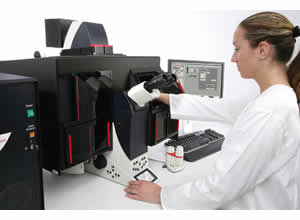Leica AM TIRF MC Microscope
Leica Updated: 2009-02-07 RSS
True MultiColor Laser TIRF
The new MultiColor TIRF (Total Internal Reflection Fluorescence) from Leica Microsystems is an all-in-one system offering four integrated solid state lasers for excitation of fluorophores in all important wavelengths. The extremely short switching times, the automatically constant TIRF penetration depth when switching from one wavelength to another and the extremely high and synchronized image recording rate open up completely new horizons for researching dynamic processes in living cells.
Key Features
* Integration of four wavelengths 405 nm, 488 nm, 561 nm and 635 nm with fast AOTF control
* Correction of the penetration depth when switching wavelength
* Combination of TIRF and fast FRET analysis
* Highest transmission of all optical TIRF components for maximum TIRF imaging speed and brilliance
* Fast image recording of up to 30 fps with simultaneous change of wavelength
Detailed Description
The elegant solution for fluorescence microscopy
Leica Microsystems TIRF system features a dynamic scanner that can be used to precisely position the laser beam and determine the exact penetration depth of the evanescent field. The powerful Leica AF7000 fluorescence software offers full control of the TIRF system. All microscope functions and many analysis tools are included.
TIRF (Total Internal Reflection Fluorescence) microscopy
The ideal technique for the study of cellular membranes and their environment. TIRF uses the evanescent field generated by total reflection to excite fluorophores. Instead of illuminating an entire specimen with excitation light, as in widefield fluorescence microscopy, the evanescent field only penetrates the specimen to a depth of 70–300 nm. Fluorochromes at deeper levels of the specimen are not excited. This method enables a substantially improved signal-to-noise ratio, providing the highest quality results. The integration of four AOTF-controlled laser lines into the Leica AM TIRF system allows fast wavelength switching and a high image recording rate with multiple fluorophores.
TIRF Membrane Research - View dynamic structures and events
Research of molecular interactions at cell membranes, of proteins and receptors involved in transport mechanisms, requires fast switching of the excitation wavelength. With Leica MultiColor TIRF, wavelengths are switched in a few ms without alteration of the penetration depth. The system's fast control and high image recording rate of up to 30 frames per second is also an advantage for FRET analysis. Using the new FRET wizard, experiments can be conducted with ease and fully evaluated automatically. If alternating wavelengths are required in the widefield light path of the TIRF module, Leica Microsystems fast filter wheels can be used. Switching times of approximately 30–50 ms are easily achievable.
TIRF Single Molecule - Explore the world of single molecules
With the Leica Microsystems TIRF system it is easy to image single molecules close to the cell membrane. Typically, a powerful objective's resolving power in the z axis is physically limited to approximately 400–500 nm by the wavelength of the light used. This physical restriction is eliminated by the high accuracy of the TIRF excitation of ~ 100 nm in the z axis. Even interactions of single molecules, the kinetics or colocalization of molecules can be visualized and measured with the Leica Microsystems highly sensitive TIRF system. The constant penetration depth when switching the laser lines is a key prerequisite for using multiple fluorophores. Due to the excellent signal-to-noise ratio, the entire dynamic range of this high-performance camera can be exploited. Even with weak fluorescent signals, the EMCCD camera provides highest resolution images while ensuring the uncompromising sensitivity essential for the gentle treatment of light-sensitive specimens.
TIRF Vesicle Transport - High resolution and minimum light stress
Due to strong background fluorescence, vesicle transport studies require an optimum signal-to-noise ratio. At the same time, stability for experiments lasting several hours or days is a must. Vesicle transport experiments are made simple with the Leica AM TIRF MC. With the addition of Leica's special climate chamber to the TIRF system, temperature and CO2 levels remain constant. The Leica AF6000 multidimensional fluorescence workstation with intelligent application software and hardware provides accurate results. For brilliant photographs of vesicle transport investigations, a high-sensitive and high-speed EMCCD camera can be used.
Light path of the Leica TIRF module. The laser beam is positioned in the objective with the aid of a scanner. The returning beam of the total reflection is measured on a special sensor. This feedback allows precise, fully automatic, and reproducible setting of the penetration depth of the generated evanescent field.
TIRF Auto-alignment
The Leica Microsystems auto-alignment function automatically finds the correlation between the penetration depths of the evanescent field and the TIRF angles (to be set). An integrated TIRF sensor detects total reflection and enables the user to easily travel to specific penetration depths. The penetration depth of the evanescent field also depends on the wavelength of the laser, in addition to the refractive indices of the coverslip and specimen. The integrated refractometer function automatically determines the refractive indices of the specimens being examined. Intelligent mathematic algorithms precisely calculate the penetration depth of the TIRF field from the wavelength, the refractive index, and the incident angle of the laser beam. The selected contrast method is always TIRF and not a mixture of laser widefield excitation and TIRF. The user can start examining a specimen at the smallest penetration depth of the evanescent field and go continuously deeper. Penetration depth can be selected according to the specimen structure under examination and the orientation of the specimen. In this way the visualized structures or processes are assigned to an exact position close to the cell membrane. TIRF gives many structural and functional insights into a cell.
Brochures
Application Notes
Related Manuals
Leica MM AF Integrated System
Leica DCM 3D Measuring Microscope
Leica DC160 Consumer Camera Kit
Leica DFC290 HD Digital FireWire Camera
Leica DFC295 Digital Camera
Leica DFC310 FX Digital Camera
Leica DFC340 FX Digital Camera
Leica DFC360 FX Monochrome Fluorescence Digital Camera
Leica DFC400 Digital Camera
Leica DFC420 Digital Camera
Leica DFC420 C Digital FireWire Camera
Leica DFC490 Digital Camera